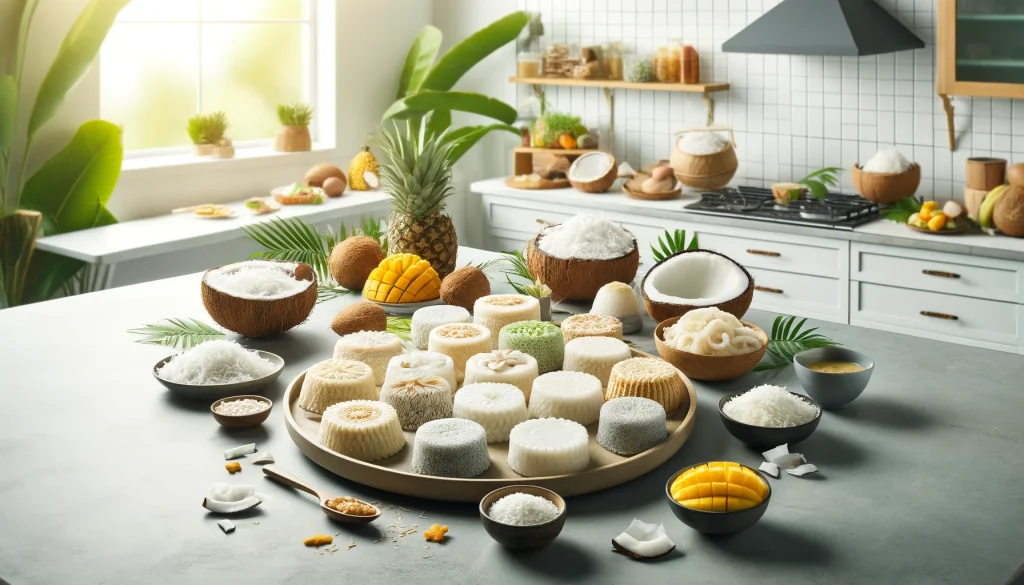As an Amazon Associate I earn from qualifying purchases.
Dive into the tropical flavors of this exquisite Coconut Rice Cake, a delightful dessert that promises to whisk your taste buds away to a paradise island with every bite. Infused with the creamy, aromatic essence of coconut, this cake is not just a treat for the senses but also a celebration of simplicity and elegance in baking. Whether you’re a seasoned baker or new to the kitchen, this recipe offers a straightforward path to a dessert that impresses both in flavor and presentation.
Originating from a rich tradition of coconut-based desserts, this Coconut Rice Cake recipe brings a modern twist to classic flavors, making it a perfect addition to any meal, celebration, or cozy night in. The use of coconut milk and shredded coconut not only ensures a moist and tender crumb but also imbues the cake with an irresistible richness and tropical aroma that’s hard to beat.
Beyond its delicious taste, this cake is versatile and adaptable, serving as a canvas for various toppings and flavor enhancements. From a sprinkle of toasted coconut flakes to a side of fresh tropical fruit, the possibilities for customization are endless, allowing you to tailor the cake to suit any occasion or palate.
In the following sections, we’ll guide you through the steps to achieve the perfect coconut rice cake, along with expert tips and answers to common questions to ensure your baking success. Get ready to experience a slice of paradise with this beloved dessert that promises to become a staple in your recipe collection.
Coconut Rice Cake Recipe

Dive into the flavors of the tropics with this Coconut Rice Cake recipe, a sweet and savory delight that promises to transport your taste buds to an island paradise. Infused with the creamy richness of coconut milk and the subtle sweetness of shredded coconut, this rice cake recipe is a perfect blend of texture and flavor. Ideal for breakfast, dessert, or a snack, it’s a versatile treat that’s both comforting and exotic.
Ingredients:
- 1 cup glutinous rice flour (also known as sweet rice flour)
- 1/2 cup granulated sugar
- 1 1/2 cups coconut milk
- 1/4 teaspoon salt
- 1/2 cup shredded coconut (fresh or desiccated)
- 1 teaspoon vanilla extract (optional)
- Butter or oil for greasing the pan
- Additional shredded coconut for garnish
Instructions:
- Preparation: Preheat your oven to 350°F (175°C). Grease a 9-inch round cake pan or a square baking dish with butter or oil.
- Mix Dry Ingredients: In a large mixing bowl, combine the glutinous rice flour, granulated sugar, and salt. Stir together to distribute evenly.
- Combine Wet Ingredients: In a separate bowl, whisk together the coconut milk and vanilla extract (if using) until well combined.
- Combine Wet and Dry Ingredients: Gradually pour the wet ingredients into the dry ingredients, stirring continuously to ensure there are no lumps. Mix in the shredded coconut.
- Pour into Pan: Once the batter is smooth, pour it into the prepared pan, smoothing the top with a spatula.
- Bake: Place the pan in the oven and bake for about 25-30 minutes, or until the cake is set and the top is golden brown. A toothpick inserted into the center should come out clean.
- Cool and Garnish: Allow the cake to cool in the pan for about 10 minutes, then transfer it to a wire rack to cool completely. Before serving, garnish with additional shredded coconut.
- Serve: Cut into pieces and serve. Enjoy this delightful coconut rice cake as a sweet end to a meal or a tropical snack any time of the day.
Tips:
- For an extra coconutty flavor, toast the shredded coconut garnish lightly in a dry pan until golden brown before sprinkling over the cake.
- If you prefer a moister cake, consider adding an extra 1/4 cup of coconut milk to the batter.
- This cake is naturally gluten-free, making it a great dessert option for those with gluten sensitivities.
This Coconut Rice Cake recipe is more than just a dessert; it’s a celebration of coconut’s natural sweetness and versatility. Whether you’re reminiscing about a tropical vacation or simply in the mood for a coconut-infused treat, this recipe is sure to satisfy.
Expert Tips for Perfecting Your Coconut Rice Cake Recipe:

- Choose the Right Rice: Opt for a medium-grain rice like jasmine or sticky rice, which has a higher starch content, perfect for achieving the desired texture in your rice cake.
- Coconut Milk Consistency: When using coconut milk, shake the can well before opening to ensure the cream and liquid are well mixed. For a richer coconut flavor, use full-fat coconut milk. For a lighter option, you can use light coconut milk.
- Balancing Sweetness: Adjust the amount of sugar according to your preference. Remember that coconut milk already adds sweetness, so you may need less sugar than in other recipes.
- Enhance Flavor with Coconut Flakes: Toasted coconut flakes can add a delightful crunch and intensified coconut flavor to your rice cake. Sprinkle them on top before baking for an extra layer of texture and taste.
- Incorporate Aromatics: Infuse your coconut rice cake with additional flavor by adding aromatic ingredients like pandan leaves or lemon zest to the cooking liquid. These subtle additions can elevate the overall taste profile of your dessert.
- Proper Mixing Technique: Be gentle when folding the shredded coconut into the rice batter to avoid deflating it. Use a spatula and fold in a downward motion, ensuring even distribution without overmixing.
- Adjust Baking Time: Baking time may vary depending on your oven and the thickness of your rice cake. Keep an eye on it towards the end of the baking time to prevent over-browning. A toothpick inserted into the center should come out clean when it’s done.
- Cooling and Setting: Allow the coconut rice cake to cool completely in the pan before slicing. This helps it to set properly and ensures neat slices. For an even firmer texture, refrigerate the cake for a few hours before serving.
- Serve with Complementary Flavors: Enhance the tropical experience by serving your coconut rice cake with fresh fruit such as mango, pineapple, or passionfruit. A dollop of whipped cream or a drizzle of coconut syrup can also add a touch of indulgence.
- Storage Tips: Store any leftover coconut rice cake in an airtight container in the refrigerator for up to 3-4 days. To maintain its freshness, place parchment paper between layers to prevent sticking.
With these expert tips, you can create a perfectly moist, flavorful, and irresistible coconut rice cake that will transport your taste buds to a tropical paradise with every bite.
Why This Recipe Is Just So Good…
The allure of this Coconut Rice Cake recipe lies in its simplicity and the depth of flavors it brings to the table, making it an exceptional treat for various occasions. Here are several reasons why this recipe stands out as an absolute delight:
- Rich Coconut Flavor: The use of both coconut milk and shredded coconut infuses every bite with the creamy, tropical taste of coconut. This double hit ensures a rich and indulgent flavor profile that coconut lovers will find irresistible.
- Perfect Texture: The combination of sticky rice or medium-grain rice with the moistness of coconut milk creates a texture that is wonderfully soft and slightly chewy. It’s a pleasing contrast to the slight crispiness of the toasted coconut flakes on top, offering a satisfying mouthfeel.
- Versatility: This coconut rice cake is incredibly versatile, serving beautifully as a dessert, snack, or even breakfast. It can be dressed up with fruit, syrups, or whipped cream, or enjoyed in its simple, unadorned state.
- Ease of Preparation: Despite its exotic flavor, this recipe is straightforward and easy to prepare, requiring basic ingredients and minimal steps. It’s accessible to bakers of all levels, from novices to seasoned experts.
- Cultural Significance: Coconut rice cakes have a place in various cultures, offering a taste of tradition and the comfort of home cooking. This recipe provides an opportunity to explore and appreciate global culinary traditions.
- Healthier Dessert Option: Compared to many desserts, this coconut rice cake can be adapted to be a healthier option. By controlling the sugar content and using natural coconut milk, it can be a guilt-free treat.
- All-Year-Round Appeal: While the coconut lends a tropical feel perfect for summer, this dessert’s comforting warmth and richness make it equally appealing during the cooler months. It’s a versatile recipe that fits any season.
- Aesthetic Appeal: The golden-brown top, contrasted with the white interior, makes this cake as beautiful to look at as it is to eat. It’s sure to impress guests and elevate any dining table it graces.
In essence, this Coconut Rice Cake recipe embodies the perfect blend of taste, texture, simplicity, and elegance. It’s a testament to how simple ingredients can come together to create something truly magnificent, making it a beloved choice for any occasion.
Storage Instructions
Proper storage is crucial for maintaining the freshness and flavor of your coconut rice cake. Follow these storage instructions to ensure your cake remains delicious for as long as possible:
Room Temperature:
- Short-Term Storage: If you plan to consume the coconut rice cake within a day, it can be covered and left at room temperature. Ensure it’s stored in a cool, dry place, away from direct sunlight or heat sources. This is only advisable in cooler climates or if the ambient temperature isn’t too warm, as coconut milk can spoil.
Refrigerator:
- Ideal for Longer Storage: For keeping the coconut rice cake beyond a day, wrap it tightly in plastic wrap or aluminum foil, or place it in an airtight container. This will help maintain its moisture and prevent it from absorbing other odors in the refrigerator. Coconut rice cake can be stored in the refrigerator for up to 3-4 days.
Freezing Instructions:
- For Extended Storage: Coconut rice cake freezes well. First, allow the cake to cool completely. Then, wrap it securely in plastic wrap, followed by a layer of aluminum foil, or place it in a freezer-safe bag or container. Label it with the date, and store it in the freezer for up to 2 months.
- Thawing: When ready to enjoy, thaw the frozen coconut rice cake in the refrigerator overnight. You can gently reheat it in the oven or microwave if you prefer to serve it warm.
Reheating:
- Oven Method: Preheat your oven to 350°F (175°C). Remove any plastic wrap and cover the cake loosely with aluminum foil. Heat for about 10-15 minutes or until warmed through. Be careful not to overheat, as this can dry out the cake.
- Microwave Method: For a quick warm-up, you can microwave slices of the cake on a microwave-safe plate, covered with a paper towel, for 20-30 seconds or until just warm. Microwave ovens vary in power, so adjust the time as necessary.
Tips for Best Results:
- Moisture is Key: If you find the rice cake has dried out a bit after storage, you can sprinkle a few drops of water over it before reheating to help add moisture back.
- Serve Properly: Allow the cake to come to room temperature for a few minutes after removing it from the refrigerator or freezer for the best texture and flavor before serving.
Following these storage instructions will help ensure your coconut rice cake remains as delicious as the day it was made, allowing you to savor every bite.
Frequently Asked Questions (FAQ)

Q: Can I use light coconut milk instead of full-fat coconut milk?
A: Yes, you can use light coconut milk if you’re looking for a lower-fat option. Keep in mind that using full-fat coconut milk will give the cake a richer flavor and creamier texture.
Q: What can I do if my rice cake comes out too dense?
A: A dense cake might result from overmixing the batter or not incorporating enough leavening agent. Make sure to gently fold your ingredients until just combined and verify the freshness of your baking powder.
Q: Can I add fresh fruit into the batter?
A: Yes, adding fresh fruit like diced mango, pineapple, or berries can add a lovely flavor and texture to your coconut rice cake. Just ensure the fruit is not overly wet, as this can affect the cake’s consistency.
Q: How can I tell when the rice cake is done baking?
A: The rice cake is done when it’s golden brown on top and a toothpick inserted into the center comes out clean or with a few moist crumbs. Be careful not to overbake, as this can dry out the cake.
Q: Is it necessary to refrigerate the coconut rice cake?
A: Yes, due to the high dairy and coconut milk content, it’s best to refrigerate the cake if not consuming it within a day. Refrigeration helps prevent spoilage and maintains freshness.
Q: Can I freeze coconut rice cake?
A: Absolutely, coconut rice cake freezes well. Wrap it securely in plastic wrap and then aluminum foil, or place it in an airtight container. It can be frozen for up to 2 months. Thaw in the refrigerator overnight before serving.
Q: My cake is browning too quickly on top. What can I do?
A: If the cake is browning too quickly, you can loosely cover the top with aluminum foil to prevent it from burning while allowing the inside to continue baking.
Q: Can I use coconut flour instead of all-purpose flour?
A: Coconut flour behaves very differently from all-purpose flour and can make the cake dry and dense due to its high absorbency. If you wish to use coconut flour, you’ll need to adjust the liquid quantities and possibly add more eggs to maintain moisture. It’s best to follow a recipe specifically designed for coconut flour.
Q: How long can I store the coconut rice cake in the refrigerator?
A: Properly stored in an airtight container, coconut rice cake can last in the refrigerator for 3 to 4 days.
Q: Can I make this cake without an electric mixer?
A: Yes, you can mix the batter by hand. Just ensure that you mix thoroughly until the batter is smooth and evenly combined. A whisk or a wooden spoon is sufficient for mixing the ingredients well.
Q: Can I use any type of rice for this recipe, or is there a specific variety that works best?
A: For the best results, it’s recommended to use medium-grain rice or sticky rice, such as jasmine rice or glutinous rice. These varieties have a higher starch content, which helps create the desired texture for the rice cake.
Q: How do I prevent the rice cake from becoming too dry or too moist?
A: To prevent the rice cake from becoming too dry, ensure you use the right amount of liquid ingredients, such as coconut milk, and don’t overbake it. To avoid it becoming too moist, make sure to drain excess liquid from the rice before mixing it with other ingredients.
Q: Can I make this recipe vegan by substituting the eggs with something else?
A: Yes, you can make this recipe vegan by using an egg substitute such as flaxseed meal or chia seeds mixed with water. These alternatives will help bind the ingredients together in a similar way to eggs.
Q: Is there a gluten-free version of this recipe available?
A: Yes, this recipe can easily be made gluten-free by ensuring that all ingredients used, including the rice flour, are certified gluten-free. Additionally, double-check that any other ingredients added, such as baking powder, are also gluten-free.
Q: Can I add other flavors or ingredients to customize the taste of the rice cake?
A: Absolutely! Coconut rice cake is quite versatile, and you can add various ingredients to customize the flavor. Some popular additions include vanilla extract, lemon zest, or even tropical fruits like mango or pineapple.
Q: How can I achieve a more pronounced coconut flavor in the rice cake?
A: To enhance the coconut flavor, you can add coconut extract or coconut essence to the batter. Additionally, using coconut cream instead of coconut milk or increasing the amount of shredded coconut can intensify the coconut flavor.
Q: Can I make this recipe ahead of time and store it for later use?
A: Yes, you can make this coconut rice cake ahead of time and store it in an airtight container in the refrigerator for a few days. Alternatively, you can freeze the rice cake for longer-term storage.
Q: How can I prevent the rice cake from sticking to the pan when baking?
A: To prevent sticking, it’s essential to properly grease the baking pan before adding the rice cake batter. You can also line the bottom of the pan with parchment paper to make it easier to remove the cake after baking.
Q: What is the best way to serve coconut rice cake?
A: Coconut rice cake can be served warm or at room temperature. It can be enjoyed on its own as a snack or dessert, or paired with fresh fruit, whipped cream, or coconut ice cream for a more indulgent treat.
Q: Can I make mini versions of this rice cake for individual servings?
A: Yes, you can make mini coconut rice cakes by using muffin tins or mini cake pans. Adjust the baking time accordingly to ensure they are cooked through. Mini rice cakes are perfect for serving at parties or as portion-controlled treats.
Conclusion
As we conclude our introduction to the Coconut Rice Cake recipe, we invite you to embark on a culinary journey filled with the luscious flavors of the tropics and the warm embrace of homemade baking. This dessert not only delights the senses but also evokes a sense of tranquility and indulgence, reminiscent of lazy days under swaying palm trees and gentle ocean breezes.
With its simplicity and elegance, this Coconut Rice Cake recipe encapsulates the essence of homemade goodness, offering a taste of paradise in every bite. Whether shared with loved ones during festive gatherings or savored as a quiet indulgence, this cake has a way of bringing people together and creating cherished memories.
As you venture into the kitchen to create your own version of this delectable dessert, remember to infuse it with your personal touch and creativity. Experiment with different toppings, flavors, and presentations to make it uniquely yours. And as you savor each mouthful of moist, coconut-infused goodness, may you find joy in the simple pleasures of baking and sharing food with those you love.
So, let this Coconut Rice Cake recipe be your guide to culinary bliss, a reminder that sometimes, the most extraordinary experiences can be found in the simplest of recipes. Here’s to the magic of homemade desserts and the memories they create, one slice of coconut bliss at a time.






